Create stained glass windows in Sagrada
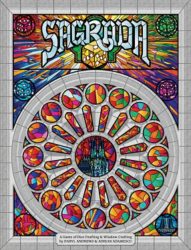
Stained glass windows are a beauty to behold.
There aren’t many near where we live. But when we’ve visited historic cathedrals on trips, we’re always impressed by the amazing artistry of towering stained glass windows.
In the new game, Sagrada, by Floodgate Games, you and your family and friends get the chance to build your own stained glass windows!
Ok, so maybe not a real stained glass window. But these colorful dice and window patterns sure give you the feeling of doing so.
Sagrada is such a colorful and eye-catching game, it’s hard to pass by and not want to play.
And the best part is that the game theme and game play are a perfect match.
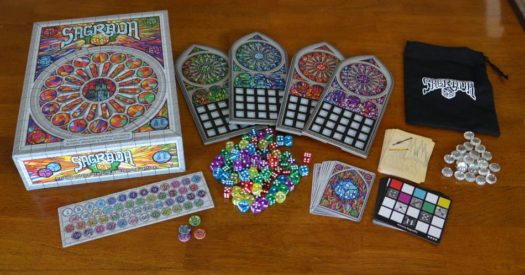
How to play Sagrada
In Sagrada, players are constructing stained glass windows using colored dice to score the most points.
Each round, players will take turns drafting from a pool of dice and placing them in their personal stained glass window. The catch is that each die must follow the unique placement restrictions for each player’s window.
Set up
To begin, each player draws 2 random, double-sided Window Pattern cards and chooses 1 to place in their personal Window Board. Players can choose either side of the card to display. They’ll also receive a number of Favor tokens equal to what’s shown on their card.
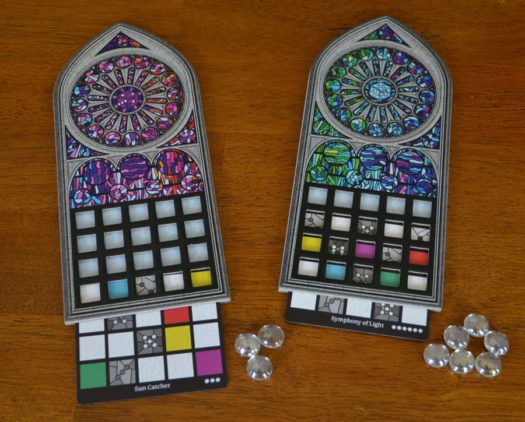
Each player also draws 1 random Private Objective card which they’ll keep secret until the end of the game. These cards match the color of the dice and reward points based on those color values in a player’s final window.
Next, 3 random Public Objective cards are drawn and placed face up in the center of the table. All players will score points at the end of the game based on meeting these objectives.
Then 3 random Tool cards are also placed in the center of the table. The powers on these cards will allow players to manipulate the placement of their dice during play.
Finally, all 90 dice are placed in the bag and players are ready to go.
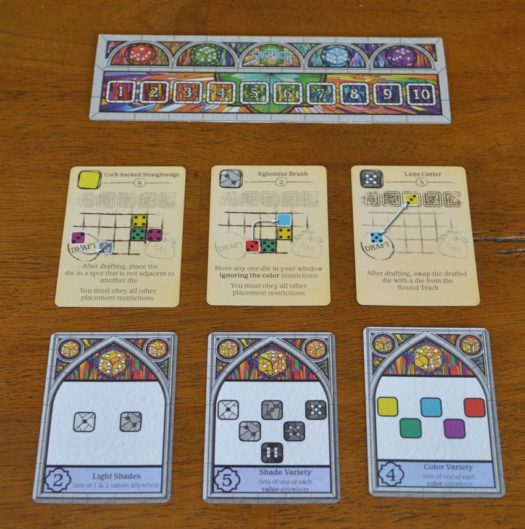
Playing a round
Sagrada is played over 10 rounds. Each round begins with the start player randomly drawing and rolling a number of dice from the bag equal to twice the number of players plus one. For example, in a 3-player game, 7 dice will be drawn at the start of each round.
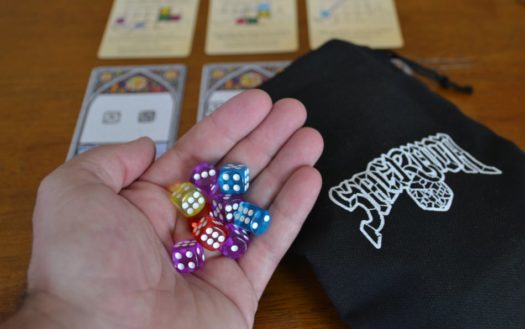
The Start Player for that round selects 1 of those dice and places it in their Window. Then the player to their left does the same. Once each player has placed their first die, the same process happens again, but in reverse order. So the last player to choose a die is now the first to choose and then the player to their right choose and places a die.
On their turn, players may also use a Tool card in addition to choosing and placing a die.
Players are not required to take either action. If they don’t want any of the available dice or to use a Tool card, they may pass their turn.
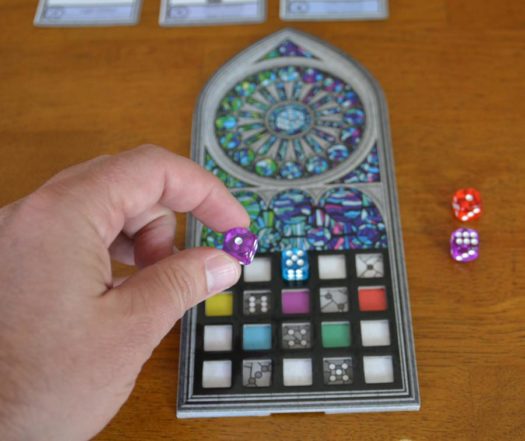
Placing dice
The tricky part of Sagrada is in the placement of the colored dice in the windows. It’s like a puzzle.
The first die placed must be on an edge space or corner. After that, every die placed must be placed adjacent to an existing die in the window (either orthogonally or diagonally).
The die must match either the color or shade (value) indicated on the space. Blank/white spaces have no color or value restrictions.
The last restriction is that a die may never be place orthogonally next to a die of the same color or value.
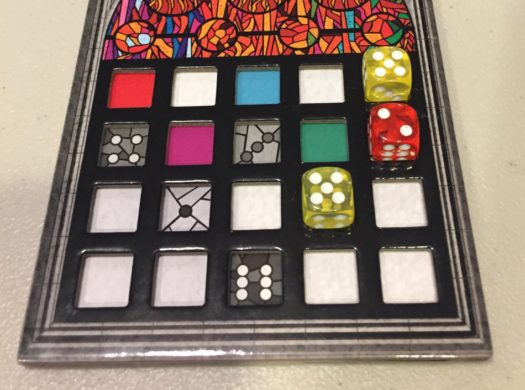
Tool cards
In addition to taking and placing dice on their turns, players can also spend their Favor token to use the ability on a Tool card.
If there aren’t any tokens already on a Tool card, the cost to use the ability is 1 Favor token. After that, each use of that tool costs 2 Favor tokens.
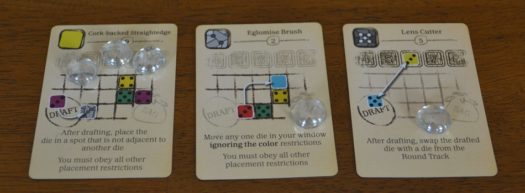
End of round and game
After each player has had two turns, one die is placed on the Round Track to show that round has concluded. The dice bag is then passed to the player on the left who becomes the new Start Player for the next round.
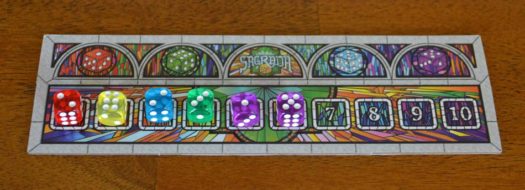
After the 10th round, the game ends and player total up their scores.
The reverse side of the Round Tracker board has a Score Tracker to use as players count up their points.
First, players total up their scores from the Public Objective cards. Then they reveal their Private Objective cards and add up those points. Finally, each player scores an additional point for each Favor token they haven’t used and loses a point for each open space in their window.
The player with the most points is the winner!
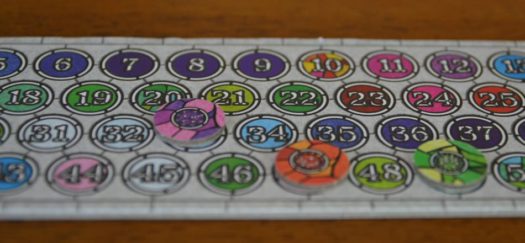
Can the whole family enjoy playing Sagrada?
Like we mentioned in the beginning, it’s hard to see Sagrada on the table and not want to join in. It’s such a colorful game to see.
The great news is that players of all ages can enjoy playing the game.
That’s not to say players of all ages will play optimally. Because it definitely takes some thinking and planning to place the dice for optimal points.
The recommended player age on the game box is 13+. However, we’d suggest something more along the lines of 9+. At that age, kids usually have a good grasp of the decisions needed in the game without getting too frustrated.
Of course, that’s not to say that even adults won’t get frustrated.
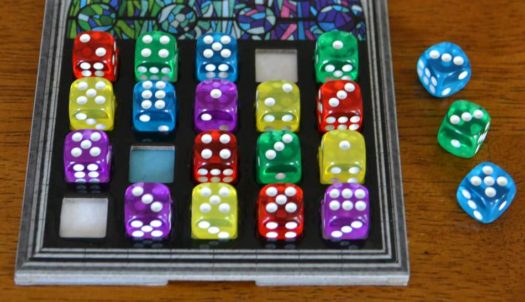
The restrictions on the dice placement are what drive the game. Players must weigh the options in their window with what colored dice are drawn and the resulting values showing.
As if that wasn’t enough, turn order also plays a big role in the game. The right color dice may be drawn and the right numbers are showing on the dice, but if those dice are chosen before you have a turn to pick, you’ll have to shift your plans on the fly.
Even though there’s a common set of Public Objective cards that everyone is trying to complete for points, since each player’s personal window restrictions are different, everyone will have to find their own unique way to get those points.
In the end though, it’s still a lighter game. So as long as players don’t stress too much about working within the placement restrictions, they’ll have a good time playing.
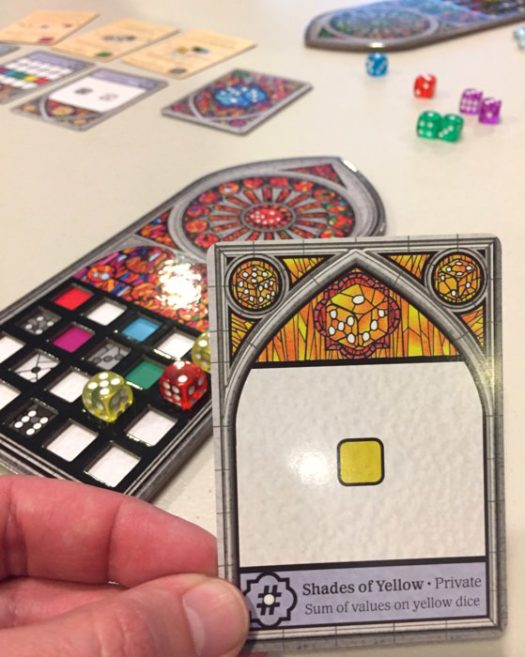
Sagrada the puzzle
Since the placement of dice drives the game, let’s take a closer look.
Regular visitors to our site may know that I love puzzle-like games. And Sagrada fits in perfectly to this realm.
There are a number of facets to the game that contribute to the puzzle.
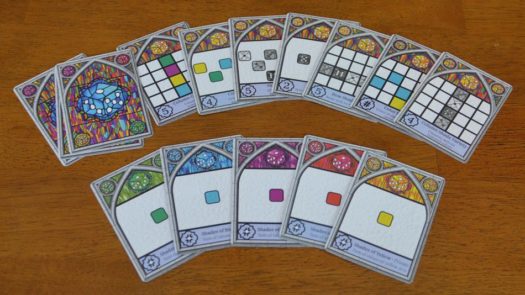
First are the windows themselves. Each window board looks like a puzzle. And as each fits into a Window board with space dividers, players even place their dice piece by piece just like a jigsaw puzzle. And in the end, everyone can sit back and admire their handiwork. It totally makes sense because stained glass windows themselves are like puzzle.
It’s a wonderful fit between game theme and game play.
Yet that’s not all.
As I mentioned before, the choices each turn are each elements to the puzzle as well: Public objectives and private objectives, the random selection of dice drawn from the bag, the random results of rolling the dice, the player turn order, the option to use Tool cards, etc.
They all work together nicely to keep my mind thinking the entire game about how to optimize the puzzle before me.
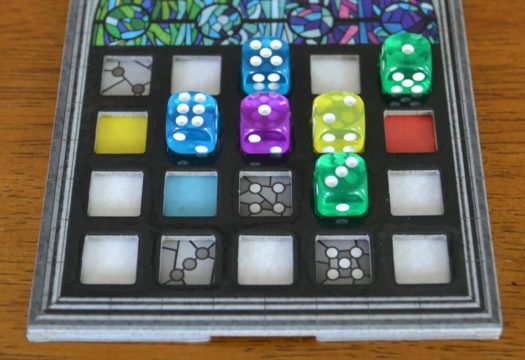
Strategy vs. Luck
With all those elements I’ve just described, it’s easy to see the vast amount of luck in a game of Sagrada.
However, it’s not devoid of strategy either.
While players may not be able to plan many turns in advance, they can set their sights on trying to achieve certain objectives at the expense of others. And this will differ from game to game because the objective cards will differ from game to game.
During game play though, choices will feel more tactical than strategic. Choosing the best die from those remaining in the pool and choosing where to place it is a tactical decision. However, it will be done with the end-game / strategy in mind. And many times players will find themselves setting up their window, hoping for certain dice results to come in a subsequent round.
But let’s not forget the Tool cards.
The Tool cards are a big factor in being able to develop a strategy and make important tactical choices to achieve it.
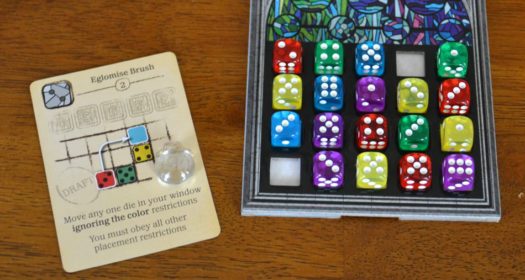
The Tool cards let players break the placement restrictions in various ways that can be extremely helpful. Using the tool cards is a big part of the game and can be used to mitigate the luck involved. The only downside is that players have a limited amount of Favor tokens to pay for the use of tools.
The amount of Favor tokens a player begins the game with depends on the window card they choose. There’s a tricky balance between the difficulty of the card and the amount of Favor tokens available. Since players dive right into the game with such a choice (which window card to pick), they should first evaluate the Tool and Objective cards at play in the game before selecting their Window card. Those initial options should help set the target strategy for that player for the game.
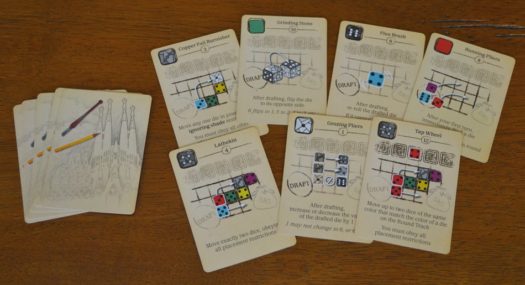
In addition, players can impact each other.
Since everyone is working on their own window, you may initially think it’s a multi-player solitaire game. However, that’s definitely not the case – because players will impact each other in the choosing of the dice from the pool.
Everyone’s window is open information. So when choosing dice, players can totally block others from getting the dice they need / hope for. If I have an option between two dice that could both work for me, and I see that you’ll need one of them, I can pick that one and leave you in the lurch. Which means that the rotating player order and the forward / reverse order of picking dice is a critical part of the game as well. It’s not all luck.
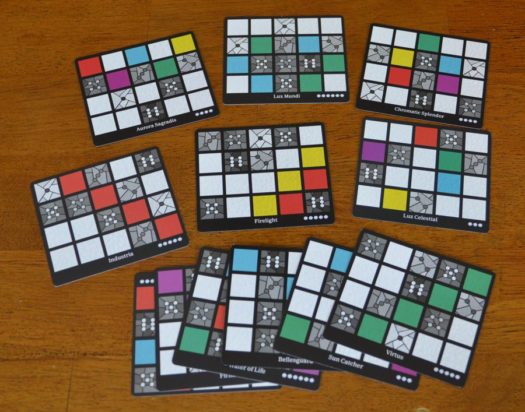
How does Sagrada score on our “Let’s Play Again” game meter?
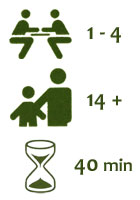 Sagrada gets mixed scores on our “let’s play again” game meter. For me, it scores very high because I love the puzzle-like nature of the game and the choices throughout the game to optimize my window based on the randomize scoring objectives each game. However, not everyone in our family is a fan of working within the placement restrictions.
Sagrada gets mixed scores on our “let’s play again” game meter. For me, it scores very high because I love the puzzle-like nature of the game and the choices throughout the game to optimize my window based on the randomize scoring objectives each game. However, not everyone in our family is a fan of working within the placement restrictions.
If you like board games, card games, or dice games that have variable set ups, a mix of luck and strategy, and challenge you to optimize your choices, Sagrada may be the right game for you.
P.S. Sagrada even has a way to play Solo! So even if you’re the only one in your family that likes puzzle-like games, you can take on this Sagrada challenge by yourself.
We’d like to thank Floodgate Games for a review copy of Sagrada.

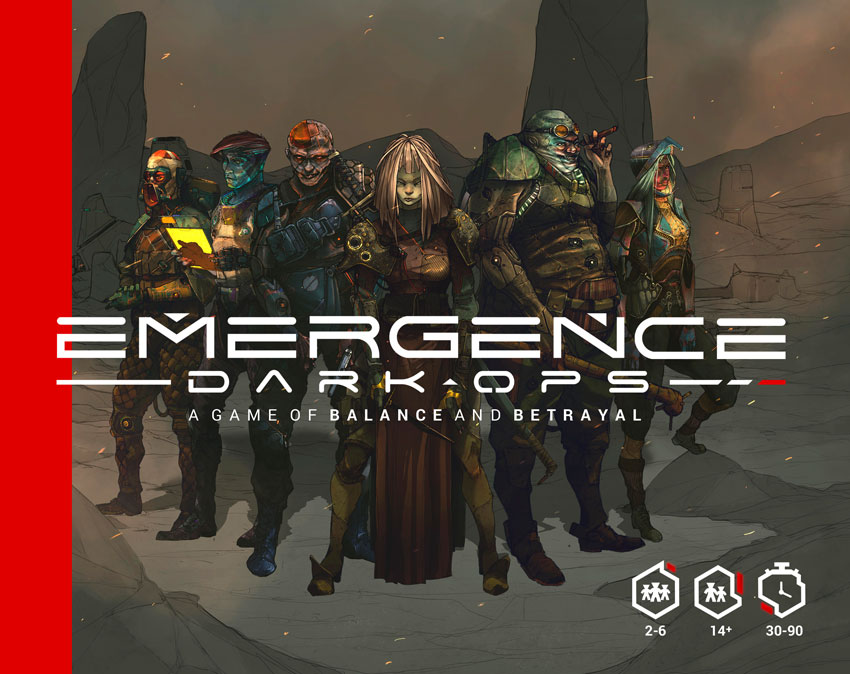
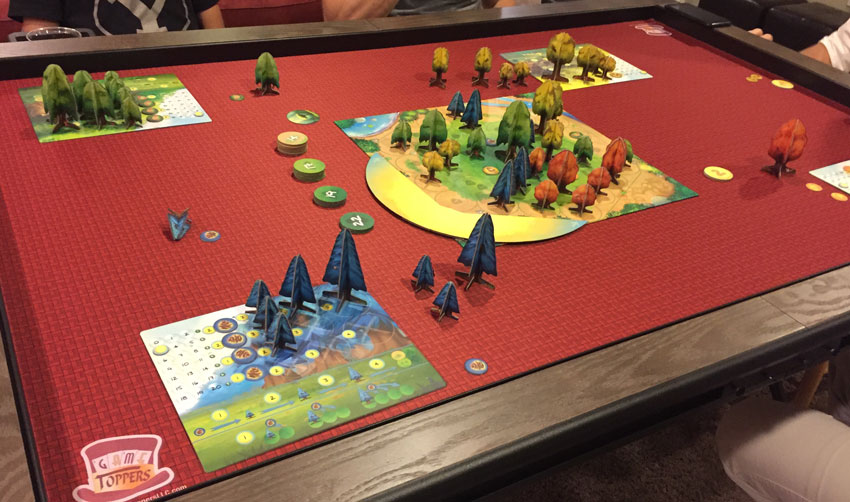

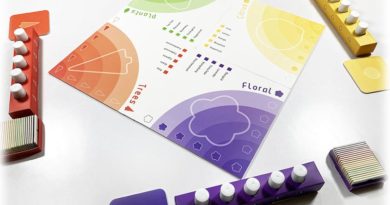
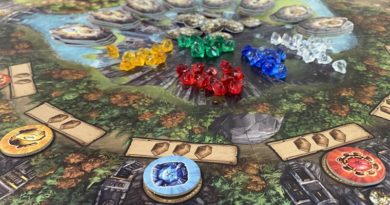
I often really enjoy a game where you can’t plan out too many steps ahead. My wife and I are often prone to the dreaded AP (analysis paralysis) but we find some dice rolling helps alieviate that.
Logan – The good thing with Sagrada is that even though there’s analysis on which dice to pick and where to place them, it doesn’t lead to paralysis.